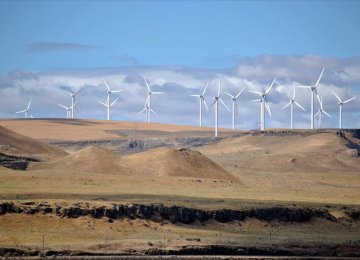Measures are being taken to generate 7,500 megawatts from solar, wind, geothermal and biomass renewable power plants by 2030 so that Iran can meet its obligations under the Paris Agreement on Climate Change.
Energy Minister Hamid Chitchian made the statement while addressing a panel on "Climate Change International Conference" in Tehran on Monday, ISNA reported.
Representatives of 195 countries including Iran negotiated a historic agreement in Paris last December to curb global emissions of greenhouse gases and limit the planet’s warming to under 2°C, preferably 1.5°C, by 2100.
Highlighting the completion of solar power plants in Arak, the capital of Markazi Province, and Hamedan last year, developed by the Renewable Energy Organization of Iran (SUNA), Chitchian said a 10 megawatt solar plant is also under construction with the help of domestic expertise in the central Isfahan Province.
According to the minister, despite taking small but important steps to prop up investment in Iran's nascent renewable infrastructure, the sector is still risky for investment "because it demands costly and methodical research before building the infrastructure that may or may not be economically viable."
He added that Iran's power industry is based mainly on fossil fuels, which explains why senior decision and policymakers in the energy sector have paid little if any attention to renewable technologies over the past four decades.
Underscoring the fact that producing 7,500 MW from renewable power plants is on the ministry's agenda, Chitchian said, “To curb air pollution, plans have also been made to convert gas-powered power plants into efficient combined-cycle plants to generate up to 7,000 megawatts of electricity with the help of F-class turbines."
Pointing to the high greenhouse gas emissions in Iran, Chitchian said the government is obliged to curb the flaring of natural gas to 10% or lower by 2021 in its declared policy to curb the worsening air pollution.
According to a law, the government is obliged to prepare the ground for investors to launch gas-flaring reduction projects by easing the terms and conditions of investment in an effort to collect and reduce at least 90% of associated petroleum gases by the end of the sixth economic, social and cultural development plan (2017-22).
Asked about dam construction projects, he noted, "Earlier plans called for building 50 dams. But that is no more a priority because more detailed climate change surveys need to be conducted to ascertain whether or not the dam projects are justified."
Stressing that global warming is an international challenge, he noted, "There is no way to fight it unless we draw on the experience of developed nations that have been partially successful in dealing with the issue."
A climate plan of action unveiled by the government in November states the compulsion for significant policy reform in the energy sector, which is responsible for over 90% of Iran’s greenhouse gas emissions.











Add new comment
Read our comment policy before posting your viewpoints